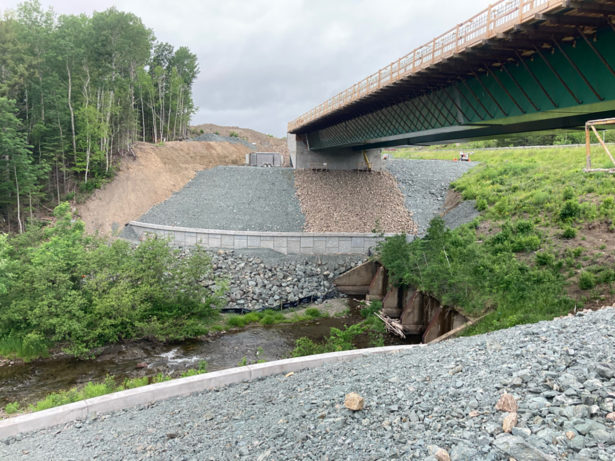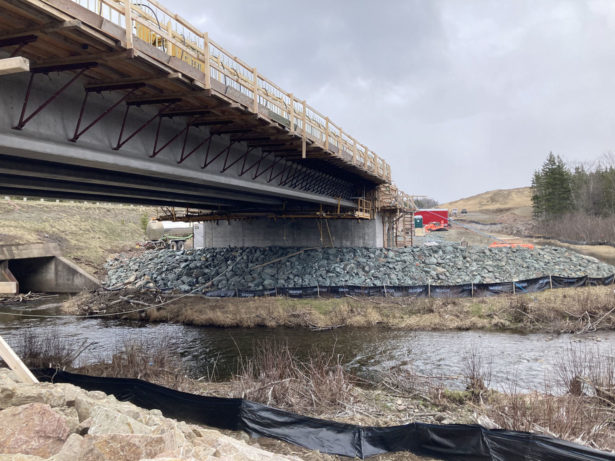Environment
Taking care of the environment
The twinning of Hwy 104 is a major project, spanning 38km between Sutherland’s River and Antigonish. In order to complete the project with the surrounding area and wildlife in mind, we’ve put an Environmental Management System in place, with a scope that covers the design, building, operation, and maintenance of the four-lane highway. This system, and our onsite Environmental team, comply with the International Standard for Environmental Management Systems (ISO 14001). Our onsite Environmental team continually visit and inspect the sites to ensure compliance with our operating procedures, environmental laws and regulations.
Our environmental considerations take into account both aquatic life and land-based wildlife.

New full span bridge in the east bound lanes is under construction at French River. Multi cell culvert (in the background) will be replaced in 2022 with a full span bridge for the west bound lanes. This crossing also has a wildlife trail and fencing to direct wildlife to a safe crossing under the bridge.

New full span bridge in the east bound lanes is under construction at Barneys River. Multi cell culvert (in the background) will be replaced in 2022 with a full span bridge for the west bound lanes.
Considerations for fish populations
- Replacing aging infrastructure and removal of multi-cell concrete culverts in fish bearing watercourses to improve system connectivity, while restoring fish habitats.
- Improving fish passage with baffled culverts in other smaller, important fish bearing watercourses.
- Conducting fish rescue operations before construction begins, to ensure no fish are impacted during the project.
- Adhere to timing windows prescribed by Nova Scotia Environment and Department of Fisheries and Oceans to lessen the impact on fish and their lifecycles.
Considerations for land-based wildlife and plants
- Wildlife passage for large mammals at bridge structures and small mammal crossings are being incorporated at designated locations.
- Wildlife fencing is being incorporated into the design to make the highway safer for both drivers and wildlife.
- We conduct wildlife surveys for species like birds, bats, turtles and protected species of trees and lichen prior to construction when we are working in special habitat areas during certain times of the year to ensure species are not impacted adversely.
Considerations for habitats and waterways
On August 17-18, Dexter Nova Alliance, together with McInnis Natural Resources, presented a two-day workshop on Introduction to Habitat and Watercourse Restoration. Over the two-day workshop, participants learned about how to conduct Habitat Suitability Index Surveys, electrofishing techniques, fish species identification, installation/maintenance of watercourse restoration structures, riparian habitat planting and succession strategies and watershed management.

Participants conduct a Habitat Suitability Index Survey in Brierly Brook.

The group installs a ‘digger log’, a stream restoration technique used to help reestablish the pool and riffle sequence in a watercourse.
The workshop was attended by over 20 participants representing the Unama’ki Institute of Natural Resources, Confederacy of Mainland Mi'kmaq, Maritime Aboriginal Peoples Council, Pictou Landing First Nation, & Paqtnkek First Nation.

Participants observe salmon and trout species that were captured during an electrofishing demonstration.

Elder Keith Christmas speaks about the significance of the Black Ash tree in the Mi’kmaq culture before planting one on the bank of Brierly Brook.